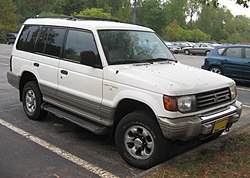 | |
| Production | 1991–1999 |
|---|---|
| Engine(s) | 4D56 2.5 TD 4M40 2.8L TD 4G64 2.4L I4 6G72 3.0L V6 6G74 3.5 V6 |
| Transmission(s) | 5-speed manual 4-speed auto |
| Wheelbase | 2,725 mm (107.3 in) (LWB) 2,420 mm (95.3 in) (SWB) |
| Length | 4,705 mm (185.2 in) (LWB) 4,030 mm (158.7 in) (SWB) |
| Width | 1,695 mm (66.7 in) |
| Height | 1,875 mm (73.8 in) (LWB) 1,850 mm (72.8 in) (SWB) |
| Fuel capacity | 90 L (19.8 imp gal; 23.8 US gal) (LWB) 75 L (16.5 imp gal; 19.8 US gal) (SWB) |
Mitsubishi sold over three hundred thousand Pajeros in 1989 and 1990[citation needed]. However, the time for a redesign was long due and 1991 saw the first Generation II Pajero. Just about everything was now new and further enhanced. A new, larger body was available in four different versions; Metal Top, Canvas Top Convertible, Semi High Roof Wagon and High Roof Wagon (long wheel base). The short wheel base models where stretched by 70 millimeters (2.8 inches) and the long wheel base models by 30 millimeters (1.2 inches). The available engines included a 3.0 liter 12-valve SOHC with ECI-Multi electronic fuel injection and a 2.5 liter turbocharged diesel engine with an intercooler.
The second generation also saw the introduction of Super Select 4WD (SS4) [known as ActivTrak 4WD in some markets] and multimode ABS, which were firsts on Japanese four wheel drives. SS4 was ground-breaking in the sense that it combined the advantages of part time and fulltime four wheel drive with four available options: 2H (high range rear wheel drive), 4H (high range fulltime four wheel drive), 4HLc (high range four wheel drive with locked center differential and 4LLc (low range four wheel drive with locked center differential). Another advantage of this second generation system is that it gave the driver the ability to switch between two wheel drive and fulltime four wheel drive at speeds up to 100 km/h (62 mph), whereas the first generation Pajero had to be stationary to switch from rear wheel drive to four wheel drive (but not from four wheel drive back to rear wheel drive). Multimode ABS, on the other hand, was equally innovative. This meant ABS would be fully functional in all modes of SS4, as braking with a locked center differential requires completely different braking parameters.
In July 1993, two new power plants were introduced; a 3.5 liter 24-valve DOHC with ECI-Multi and a 2.8 liter turbocharged diesel with an intercooler. A new, larger transmission and transfer case was also part of the upgrade.
The Pajero Evolution was introduced in October 1997, which was developed in response to new entry requirements for the Paris – Dakar Rally’s T3 Class. The Pajero Evolution came standard with a 3.5 liter 24-valve DOHC V6 with Mitsubishi Innovative Valve Timing and Electronic Lift Control (MIVEC). A new, dual plenum variable intake helped increase power and a new suspension made the ride even smoother.
In 1998, vehicles destined for General Export and the GCC (Gulf Cooperation Council Countries) received a facelift. Wider fenders, new headlights, grille, bumper, fog lights and sidesteps were all part of the redesign. The wide fenders are often called "blister flare fenders". Driver and front passenger SRS airbags were made standard on models equipped with the 3.5 liter DOHC V6 engine, whilst still remaining optional on GLS models with the 3.0 liter SOHC V6. An upgraded interior wood trim was made available on 3.0 liter GLS and 3.5 liter models. A leather-wrapped or leather and wood trim steering wheel was also made available, alongside an upgraded suspension and steering system. The 3.0 liter 12-valve SOHC engine was now available with a 24-valve configuration. Models without wide fenders remained as base models (GLX), available with a 2.4 liter 16-valve DOHC engine, producing 147 hp (110 kW). The 3.0 liter 12-valve engine was optional on these GLX models, and remained the base engine on the GLS.
The second generation was introduced on January 22, 1991 and manufactured until 1999. It retained the two body styles, but design was rounder and more city-friendly than the previous bulky model. The 3.0 L V6 gasoline engine was retained, now available with a 24-valve head, capable of 136 kW (183 hp/185 PS), while the 2.5 turbodiesel's power was slightly increased to 73 kW (98 hp/99 PS). In 1993, the Pajero was slightly restyled, and larger engines were introduced, a 3.5 L V6 with 153 kW (205 hp/208 PS) and a 2.8 L SOHC turbodiesel rated at 92 kW (123 hp/125 PS). These versions introduced Mitsubishi's Super Select four wheel drive system (known as Active-Trac in the United States), with an electronic transfer shift that could split power between both axles without the need to stop the car. It worked at speeds up to 100 km/h (62 mph).
The first generation Pajero was also marketed as the Hyundai Galloper in Korea, Europe and GCC Countries, while the second generation was in production elsewhere.
This model remains in production in India, whereas the latest generation is sold there as the Montero. And in the Philippines as the Pajero 2.8 Field Master 4x2 alongside with the 4th Generation Pajero. 4X4 Pajero is on production until 1999. It is known to be the only one of its kind among Pajeros worldwide to delete the Super Select 4WD drivetrain. This was accomplished in the year 2000 to avoid taxes slapped on 4 Wheel Drive SUVs imposed by the Estrada Administration. It is still in production in Colombia, with CKD parts (Complete Knock Down), with 2.4l 16 valve SOCH(130PS)and 3.0l 12 valve (148PS) , these engines are available only in hard top 3-door and the 5 door only with the 3.0l engine.

0 comments:
Post a Comment